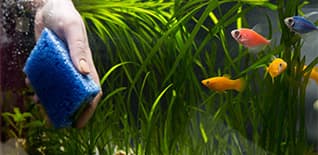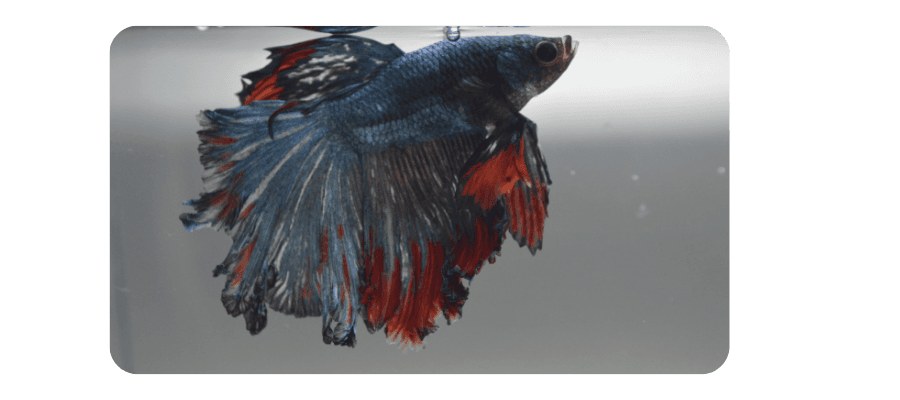Table of Contents
Attention all fish and fish fans: school is in session. For our first lesson? How to treat a sick fish.
Since you can’t load them into a crate and cart them to the vet, keeping your fish healthy is the way to go.
Still, even the most diligent of aquatic enthusiasts can find themselves with a feverish fish. So it’s important to be prepared – and able to spot the signs of the most common fish diseases.
Below, we’re covering prevention and treatment options – to keep your finned friends feeling fin-omenal.
The Foundations of Fish Health
The belief that fish are low-maintenance is a fishy falsehood. Any seasoned fish-keeper will laugh at the thought – but if you’re new to the fish-keeping game, you might not know it yet.
Lots of aquatic ailments can be attributed to poor water quality. So before we swim ahead, let’s cover how to cray-ate a healthy home for your fish:
- The right parameters - Do you know what pH balance your fish like best? Are you being a clown-fish, with high nitrate and ammonia in your aquarium? Test your water – regularly – to keep your fish afloat (in the figurative sense).
- The right temperature - Do you have goldfish? Guppies? African cichlids? Coldwater fish, like goldies, prefer temperatures between 20°C and 23°C. Tropical fish, like cichlids, are pickier: think 23°C to 27°C. So make sure you’ve got a quality heater – if your fish need one, that is – and a trusty thermometer.
- Plenty of oxygen - Fish, uh, need water. But their water needs to be oxygen-rich: that comes from a quality filter, an aquarium with a wide surface area, and the right amount of fishy friends. (Too many and there’ll be too little oxygen to go around.)
But, like Marlin and Nemo, no fish parent can protect their pet from everything. So let’s look at what to do if your fish gets the flu.
Five fishy diseases – and how to cure them
-
Ich
If your fish has the ick, it could be from ich. (That’s Ichthyophthirius multifiliis, to you.)
Ich is a parasitic disease that causes white spots to appear all over your fish’s body. It’s also the sound you’ll make when you spot them.
Along with its spots, you might catch your ich-infected fish scraping itself against rocks or decorations – or hiding a lot.
Ich most commonly affects freshwater fish. That’s because it thrives in cold water – which is why upping the water temperature by a couple degrees can kill it off quick. (So grab a heater if you’ve got goldies.)
If it’s left untreated, this little ich can become a big ew. It spreads quickly, and eventually becomes treatment-resistant.
After tweaking the temperature, treat the whole tank with a premium fungal treatment: like API’s Pimafix Aquarium Fungal and Bacterial Infection Treatment. Double down with a little disinfecting aquarium salt and your fish will be swimming-fit soon enough!
-
Velvet
Unlike ich, velvet sounds okay. But we’re talking about fishy diseases, here: let’s not get ahead of our shells.
Velvet (Oodinium) is a parasitic disease that coats your fish’s body in a velvet-like film. The film might be brown or yellow – either way, it’s not a good look! (So tell your finned friend to stop fish-ing for compliments.)
This parasite is common in aquariums, but usually only in low numbers. It multiplies easily when the water quality takes a dive, so keep on top of your water changes!
If you spot any velvety fish, use a medication containing copper to put those parasites in their place. Just read up on your fishies’ sensitivities first: some fish can’t handle their copper.
-
Fin Rot
Fin rot is pretty strait-forward. It’s a bacterial infection that frays the fins of your poor wet pets.
Poor water quality is a common culprit. As are stress and injury – so fish who are known to roe with their frenemies are at a high risk for this one.
Fin rot only gets worse if it’s left untreated, so pick up an antibacterial medication. The Melafix Aquarium Bacterial Infection Treatment from API is a perfect fix.
A few doses of this API Stress Coat Aquarium Water Conditioner will speed the healing and regrowth of your poor fish’s fins. But limiting the spread is always your best bet.
All the more reason to stay on the front fin!
-
Ammonia Poisoning
Ammonia is a fact of life for fishies. It’s a compound that’s always present in water – but when ammonia levels spike, your fish will blub ‘yikes’.
An ammonia-poisoned fish is easy to spot: they’re usually at rock bottom – of their pond or aquarium. Fish don’t sit by nature, so that’s a bit of a red flag. They also won’t eat or socialise, and their eyes might become cloudy.
The remedy? Reel those ammonia levels right back in. Use this API Ammonia Test Kit to see where things are at. If the levels are higher than 0.25 ppm (parts per million), change 25% of the water quick smart.
This Aqua One Aquarium Vacuum will make siphoning out water an easy job. When you replace it, never forget your tap water conditioner!
-
Dropsy
Is your fish looking more urchin-y than usual? It might have come down with a case of dropsy.
Dropsy causes fish to become bloated, sometimes to the point that their scales stick out.
It might be caused by a bacterial infection, or even a kidney problem. It’s a tough one to cure – though not impossible!
Scoop out your little round friend and pop them in a quarantine tank. Test the water quality (pH, ammonia and nitrite in particular), dose them up with antibiotics and wait for them to snap-per out of it.
Keep them well-fed to boost their recovery. Sinking Pellets are perfect for medium-sized fish who are feeling fragile.
And if the going gets puff, remind your finned friend to just keep swimming.






























